In the age of genomes, new information is reshaping our understanding of life on Earth.
This information cannot be ignored, and questions are rising in the Church. How much does evolution press on theology? Was Adam a real person from whom all mankind descends?
In Adam and the Genome, the scientist Dennis Venema explains our origins as most scientists understand it, with special attention to genomic data and human evolution. Assuming this science is correct, the theologian Scott McKnight, “rethinks” Adam and Eve using historical and cultural context of the original authors as a guide, but with evolution in view. Ironically, their ambitious proposal is surprisingly concordist:http://biologos.org/blogs/guest/the-various-meanings-of-concordism and http://biologos.org/blogs/jim-stump-faith-and-science-seeking-understanding/adam-and-the-genome-some-thoughts-from-scot-mcknight/. “accepting the reality of genetic evidence supporting a theory of evolution along with an understanding of Adam and Eve that is more in tune with the historical context of Genesis” (p. 173). A historical Adam can neither be identified in science nor in Scripture; both concord in refraining to teach (or deny) that Adam and Eve are real people from whom all mankind descends.
Venema is a gifted scientific writer. As most scientists would, I agree with the science in this book and urge skeptical readers to take this account seriously. However, Venema omits important scientific information that materially affects the theological response. Compounding these omissions, the introduction articulates the “assumption” that Venema’s science is correct (p. xii). Consequently, it appears that McKnight believes genetics rules out Paul’s genealogical Adam, even though this is not the case. This scientific error seems to unduly shape his interpretive goals.
Moreover,The authors do talk of “dialogue” between science and theology, but the conversation in this book is one-sided. it is hard to endorse an after-science approach to Scripture; reading beforeReading before science, John Walton’s The Lost World of Genesis One and The Lost World of Adam and Eve books explains an interpretation rooted in the cultural context of the original authors. or withReading with science, Deborah and Loren Haarsma’s articulates five “scenarios” consistent with both Scripture and the plain reading of our genomes (Origins, ch. 12). science would be more grounded. The authors do talk of “dialogue” between science and theology, but the conversation in this book is one-sided. Missing key caveats, Adam and the Genome implies that evolution itself requires a dramatic “rethink” of Adam. Biblical exegesis appears subservient to an accurate but poorly delimited scientific account.
Consequently, Adam and the Genome is best understood as a partial explanation of the relevant evolutionary science. It also explains why some Christians do not affirm a historical Adam, but a better account would explain this without assuming science.
The Plain Reading of Genomes
Venema reports a real shift in science as genetic data becomes the backbone of biology and medicine. Genomes are transforming our understanding of everything, and they convince most Christians in science that evolution is the way God designed us.
Venema accurately recounts human origins, as most scientists understand it, with clear explanations of genomes and the mathematical models that make sense of them. Anatomically modern humans arose as a group that never dipped in size to a single couple. Correctly, he explains that science cannot tell us about the “historicity” of Adam and Eve, cautioning that Y-Chromosome Adam and Mitochondrial Eve are not the founding couple of humans. He rightly explains that skeptics in the Church fail to engage the plain reading of genomes, unconvincingly dismissing it as “speculative,” rather than proposing and quantitatively testing their own mathematical models.To their credit, a few groups have very recently proposed genetic models of a single-couple origin. However, none yet have been tested on the full range of relevant genetic data (global SNP variation, linkage disequilibrium, exome variation, etc.), and it is unclear if any of these models could work. For example, Reasons to Believe (private communication) and another team led by Dr. Ola Hossjer (Genetic Modeling of Human History) have proposed conceptual models that might allow for a sole-couple origin, but neither group has mathematically formalized these models to test if they are consistent with the full range of genetic data. Venema cannot be faulted for failing to mention these recent, speculative, and untested models.
I first encountered genomes as a student. With quantitative and mathematical detail, evolutionary theory explained the patterns of similarity and dissimilarity between the human and chimpanzee genomes. God could have falsified common ancestry in our genomes, for all the world to clearly see. He did not. Why not?Of course, “common function” generically explains why genomes are similar, but common descent more accurately explains the patterns of similarity we see. For example, a mathematical equation in evolutionary theory, verified with direct experiments, explains why mice and rat genomes are 10 times more different than human and chimpanzee genomes (http://peacefulscience.org/evidence-and-evolution/ ). Common descent is the only known design principle that quantitatively explains this fact, and a thousand others like it. Even if evolution is false, it is explaining something about biology more than “similarity is due to shared function.” At the very least, my Creator was much less intent on disproving evolution than I. Whether evolution is true or false, it certainly looks like our genomes descend from common ancestors with the great apes. Even if it is ultimately false, evolution is the plain reading of genomes.
Jesus Stands Alone
A robust Christology is painfully absent from most faith and science contributions. When mentioned, Jesus is a bystander, useless to the debate but threatened all the same. This fragile Jesus is nothing like the One we find in Scripture. I applaud McKnight for breaking this pattern in arguing correctly that Jesus is not threatened by our debates over Adam.
McKnight studies how Paul’s Adam interacts with Jesus. He observes Paul could be reasoning from Jesus to Adam (p. 181). Paul’s Adam, rather than a starting point from which to define Jesus, is instead an explanatory contrast by which to expound a Jesus clearly seen by other means (Heb. 1:1-3); a Jesus who stands alone, without need of Adam. McKnight’s reframing is consistent with the rest of Scripture, which calls Jesus the “cornerstone” (Eph. 2:20), grounding everything in the Resurrection instead Adam (1 Cor. 15:3-7, 14; Acts 17:16-34). Underscoring this point, there were many versions of Adam in Paul’s time. In full view of these many Adams, the early Church did not insert one into the historical creeds. We do well, then, to remember that the traditional marker of orthodoxy is the historicity of Jesus and the Resurrection, not Adam, and a confession that He rose from the dead (Rom. 10:9).
There is much more Christology could offer. Venema and McKnight might have calmed concerns of many readers with personal confessions.‘When people utter the sentence, “I confess that Jesus is Lord,” they are confessing. They are not stating a fact about Jesus. They are enacting a commitment by speaking. By making the confession, you bind yourself to what you confess.’ Okamoto, Joel (2015) “Making Sense of Confessionalism Today,” Concordia Journal: Vol. 41: No. 1, Article 5. http://scholar.csl.edu/cj/vol41/iss1/5/ They could have explained how and why they personally came to know Him, affirm His Lordship, and believe the Resurrection. Confessing Jesus’ authority over all things, including science (Matt. 28:18-20), might have averted their after-science framing too. From the Empty Tomb, it seems untenable to interpret the Gospels after assuming the solid scientific conclusion that men never rise from the dead. Science is blind to the Resurrection and this blindness declares its limits; science cannot bring us to God or speak of when He acts. Therefore, in view of Jesus, why interpret any Scripture after assuming science?
Moreover, McKnight’s historical-contextual hermeneutic would be better understood by explaining its impact on our understanding of Jesus. Many are suspicious of an unfamiliar hermeneutic that justifies rethinking Adam. When applied to Jesus, will this hermeneutic rethink Him too? Will it rethink away the bodily Resurrection? A large body of workPersonally, I am shaped by N.T. Wright’s The Resurrection of the Son of God, but another important work is The Resurrection of Jesus by Gary Habermas. uses a historical-contextual hermeneutic to study the Resurrection, revealing it more lucidly than a plain reading. With this hermeneutic, some details of Adam are darkened, but Jesus Himself grows brighter.
These points aside, I agree with McKnight’s main thesis. Fear not an ambiguous Adam; find confidence in the lucid clarity of Jesus. We follow Him because He rose from the dead,An explanation of the evidence I point to for the Resurrection is here: http://www.veritas.org/evidence-easter-scientists-list/. whether Adam is historical or not.
The Scientific Omissions
Nonetheless, I depart from Adam and the Genome in its treatment of the historical Adam, and I specifically dispute their dismissal of a genealogical Adam. I am an evolutionary creationist who affirms Adam and Eve were real people in our past to whom we trace our lineage. I affirm a genealogical Adam.
Venema makes two critical omissions in his account that materially affect the subsequent analysis. The omitted information limits the way evolution presses on theology, and calls into question McKnight’s rethink of Adam. Unfortunately, the science I am sharing here has been overlooked by most, so it will be surprising. Here, I include a brief overview with extensive footnotes, but a more complete introduction is published at my site, Peaceful Science.
The first omission is the distinction between “human” in science and “human” in theology. Specifically, science focuses on anatomically modern humans. This is a matter of practicality because there is no way of detecting the breath of God and His Image on us. Therefore, we cannot locate Adam in history, let alone determine who descends from him. Science can, however, ask if ancient bones look like those of modern humans. Alongside anatomy, paleoanthropologists identify several milestones. Roughly speaking, 200,000 years ago we appear, 80,000 years ago we leave Africa and spread across the globe, 10,000 years ago we discover agriculture, and 10,000 years ago began recorded history. At which point did we become the “mankind” of Scripture? And when and how did we receive God’s Image? Are Neanderthals and other hominids part of mankind too? Science cannot and does not say.
The second omission is the distinction between genealogical and genetic ancestry, which obscures the well-established science of bi-parental genealogical ancestry.Our common bi-parental genealogical ancestors are (1) not our most recent common ancestor (MRCA), (2) not our identical ancestors, (3) not our mitochondrial Eve, (4) not our Y-Chromosome Adam, and (5) not necessarily our genetic ancestors. Whatever you may know of these things, common genealogical ancestors are different (Joseph Lachance, “Inbreeding, Pedigree Size, and the Most Recent Common Ancestor of Humanity,” Journal of Theoretical Biology 261, no. 2 (November 21, 2009): 238–47, doi:10.1016/j.jtbi.2009.08.006 and Simon Gravel and Mike Steel, “The Existence and Abundance of Ghost Ancestors in Biparental Populations,” Theoretical Population Biology 101 (May 1, 2015): 47–53, doi:10.1016/j.tpb.2015.02.002). Defined genealogically, universal common ancestors are everyone to whom all humans alive can trace their lineage. The first surprise is that a large group of people fit this criterion.We can build our intuition about this by considering a group of grandchildren that share the same grandfather. The grandfather is their common genealogical ancestor, but so also is every ancestor of the grandfather. There will also be other common ancestors too, if we take into account the distant shared ancestors of their parents. The second surprise is that our last universal genealogical ancestor might have been very recent, perhaps just 3,000 years ago.We can build our intuition about this by considering the total population and the number of ancestors there are as we count back generations. First, we have two parents, then four grandparents, then eight great-grandparents. The number of ancestors we have increases exponentially as we go back, but the population does not. The number of people either stays constant or decreases exponentially as we go back in generations. Eventually, all our lines begin to cross and all our lines coalesce together (Joseph T. Chang, “Recent Common Ancestors of All Present-Day Individuals,” Advances in Applied Probability 31, no. 4 (December 1999): 1002–26, doi:10.1017/S0001867800009587). Our first common father appears quickly, in just a few thousand years, but we find millions of common fathers stretching back to the first moment humans appear. Only tiny amounts of migration give us a common ancestor just 3,000 years ago. (Douglas L. T. Rohde, Steve Olson, and Joseph T. Chang, “Modelling the Recent Common Ancestry of All Living Humans,” Nature 431, no. 7008 (September 30, 2004): 562–66, doi:10.1038/nature02842). Informally extrapolating this to all humans in recorded history, common ancestors might be situated more recently than 10,000 years ago. The third surprise is that most our genealogical ancestors are “ghosts” that leave no genetic trace in our genomes, and are therefore undetectable.Most of our common ancestors are genetic ghosts “who are simultaneously (i) genealogical ancestors of each of the individuals at the present, and (ii) genetic ancestors to none of the individuals at the present.” (Simon Gravel and Mike Steel, “The Existence and Abundance of Ghost Ancestors in Biparental Populations,” Theoretical Population Biology 101 (May 1, 2015): 47–53, doi:10.1016/j.tpb.2015.02.002). So we find several anatomically modern humans, each of whom are ancestors of us all, stretching from more than 200,000 years ago to more recently than 10,000 years ago. All these individuals are unobservable by genomic science and universal genealogical ancestors of us all.
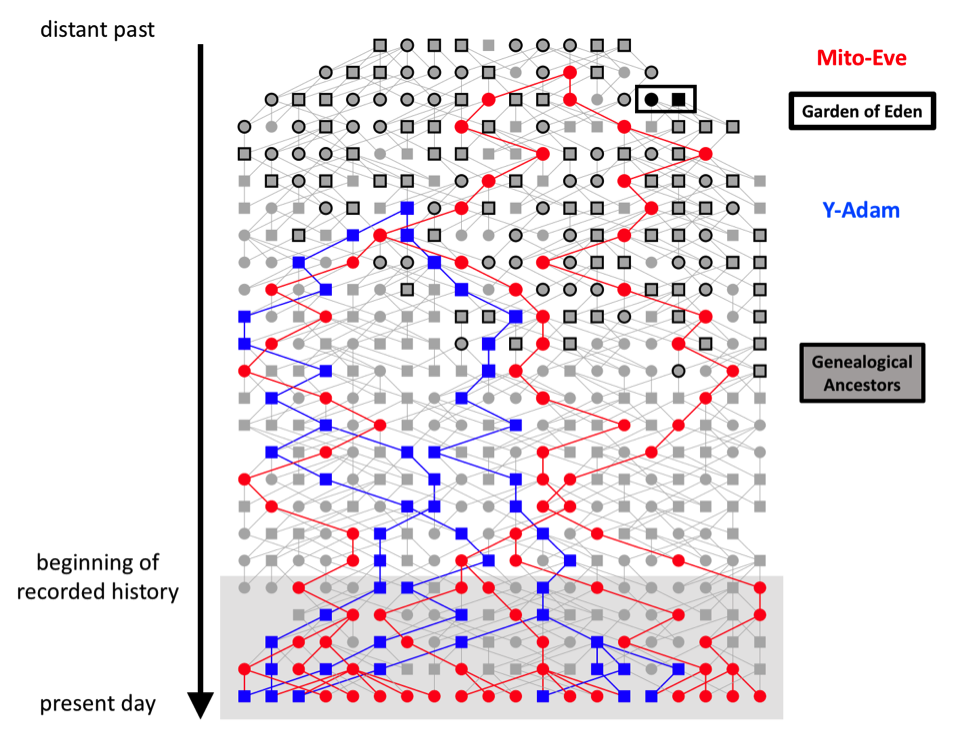
Figure 1. Genealogical ancestry is not genetic ancestry. Illustrating the story in the text, we show a cartooned pedigree, a genealogy, from past (top) to present (bottom). Squares and circles denote men and women, respectively, with lines indicating parentage. Red and blue individuals are those in the genetic lineages to a single ancestor, Mito-Eve and Y-Adam, respectively. In contrast, every individual with a black border is a common genealogical ancestor of all those in recorded history (grey box). The Scriptural Adam and Eve (the black box and square) are created from the dust and a rib less than 10,000 years ago, have no parents, are in the Garden of Eden (black box), and are genealogical ancestors of everyone in history. This story is entirely consistent with the genetic data (see http://peacefulscience.org/genealogical-science/ for more information).
Therefore, entirely consistent with the genetic evidence (Figure 1), it is possible Adam was created out of dust, and Eve out of his rib, 10,000 years ago in a divinely created garden where God might dwell with them, the first beings capable of a relationship with Him. Perhaps their fall brought accountability for sin to all their descendants. Leaving the Garden, their offspring blended with their neighbors in the surrounding towns. In this way, they became genealogical ancestors of all those in recorded history.The possibility of an Adam and Eve like this is “essentially unobservable” in genetic data past about 15 generations (J. Kelleher et al., “Spread of Pedigree versus Genetic Ancestry in Spatially Distributed Populations,” Theoretical Population Biology 108 (April 1, 2016): 1–12, doi:10.1016/j.tpb.2015.10.008). It is also not clear what group of people must descend from Adam; I choose all those in recorded history here, but one could easily choose “those alive at the time of Paul” instead. Adam and Eve, here, are the single-couple progenitors of all mankind.Remember, several other scenarios include Adam as a real person at the headwaters of humanity. Even if this scenario is false or unnecessary, nothing in evolutionary science unsettles this story. So, evolution presses in a very limited way on our understanding of Adam and Eve, only suggesting (alongside Scripture) that their lineage was not pure. Any case claiming that evolution itself requires more dramatic rethinks of Adam is in scientific error.
Why would we think, therefore, that “accepting the genetic evidence for a theory of evolution” is in “tune” with a radical revision of the traditional interpretation of Genesis (p. 173)? Instead, evolution gives no reason to doubt, as Jack Collins puts it, that Adam and Eve sit at the “headwaters” of all mankind. Genomes give no reason to doubt, as John Walton puts it, “Adam and Eve are historical figures–real people in a real past.”John Walton, “A Historical Adam: Archtypal Creation View,” in Four Views on the Historical Adam, ed. Ardel B. Caneday, Matthew Barrett, and Stanley N. Gundry (Grand Rapids: Zondervan, 2013), 89.
For these reasons, Adam and the Genome’s ambivalence to the genealogical Adam is a non-sequitur. McKnight seems unaware that evolution does not challenge Paul’s understanding here. McKnight’s rethink of Adam on this point, therefore, is not the response required by evolution. One does not follow from the other. Adam and Eve could be ancestors of all mankind. On this point, therefore, McKnight’s rethink of Adam must come on its own, independent of evolution, and without assuming science.
The Final Piece
A final piece is missing. Why end opposition to evolution? Why accept any revision, no matter how small, to accommodate evolution? I return to my story.
For decades, I had used arguments against evolution to build my confidence. I somehow felt my trust in Jesus was completed by knowing evolution was false. In this way, I trusted in Intelligent Design and creation science, but doubted the work of God in history to reveal Himself. Anti-evolutionism quietly became a foundation of my faith, on which too much rested.
The turning point came for me in Jesus. He encountered me again. Through Him I found a confident faith, rooted in God’s work in history rather than human efforts to study nature. Founded in the life, death, and resurrection of Jesus. Declared in the testimony of all believers. Confessed in my own true experience of Him. Evolution is powerful, but Jesus is greater than anything I find in science. In Him, I find no fear.
With trust in Jesus, I approached evolution anew. This is the moment it all made sense. Genomes were clear, suggesting alongside Scripture only minor adjustments to the “traditional” interpretation. In the clear light of Jesus, I no longer needed anti-evolutionism. The Resurrection is the “only sign given” by which God makes Himself known to our skeptical world (Matthew 12:38-45). This sign was perfect, in no need of completion. Not needing anti-evolutionism any more, I left my idol to follow Jesus.
Now, I see common descent is the design principle that explains so much of biology, including genomes. It looks like evolution is God’s wise way of creating us all. As Venema proclaims: “Evolution versus Is Design” (p. 89). I know God creates because God reveals Himself as the Creator through Jesus. Science struggles to see, but I believe because I trust Jesus more.
Now I face a mystery. We do not know all the details; a very large number of scenarios are consistent with science and Scripture. What are the details? How could we know?
Facing a grand mystery, I fall into the worship of creative curiosity.
I fall into the “theologized fiction” of C.S. Lewis. Instead of clinging to a fragile theology unsettled by intelligent aliens, The Space Trilogy “imagined out loud” a vision of Jesus in a universe with life on other planets. Instead of grasping at fine-tuning arguments, The Chronicles of Narnia embraced the multiverse with a vision of Jesus too. “I am in your world,” said Aslan. “But there I have another name. You must learn to know me by that name. This was the very reason why you were brought to Narnia.”
Our generation needs fearless creativity. Come let us worship with curiosity, imagining new stories of Adam that give a clear vision of Jesus to our scientific world.
***Editors note: In discussing the illustrative scenario in an earlier version of this essay, a drafting error left the text saying 6,000 years, in conflict with the figure caption, which says 10,000. If “recorded history” is the key time point, then the date should be 10,000 in both places. If “when Paul wrote Romans” is the key point, then it could be either 6,000 or 10,000 years. A detailed technical paper, currently under review, is available on request from Dr. Swamidass.
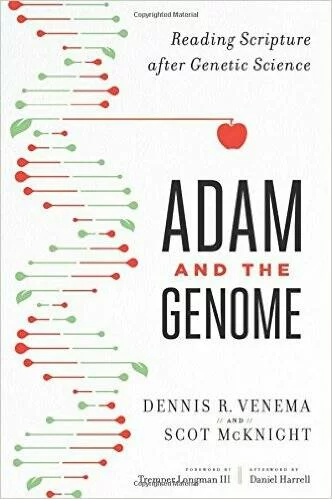


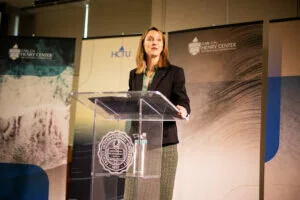
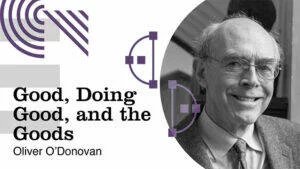
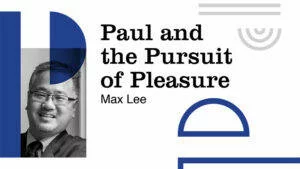


Comments
Be the first one to make a comment!